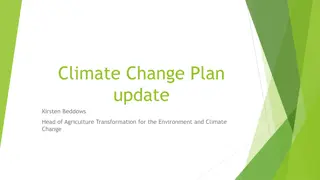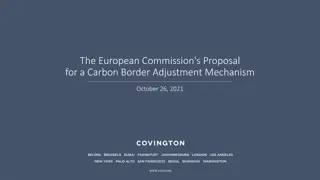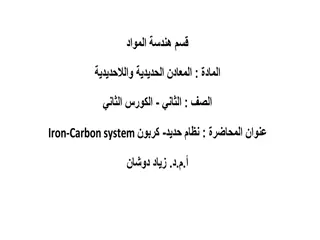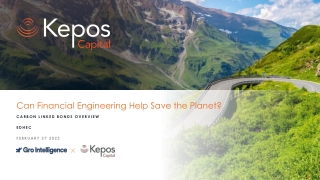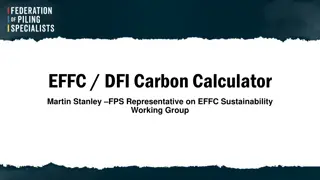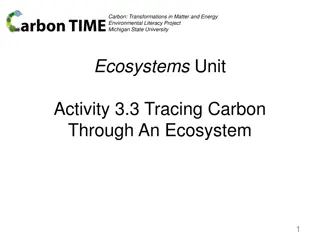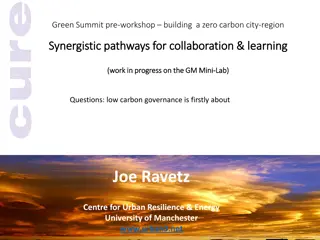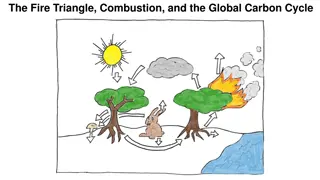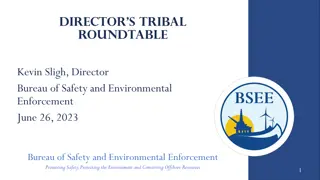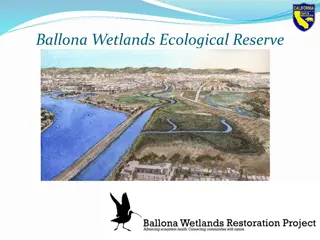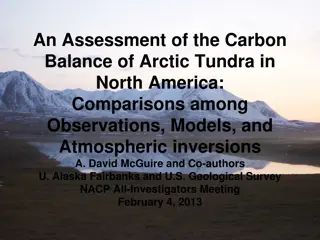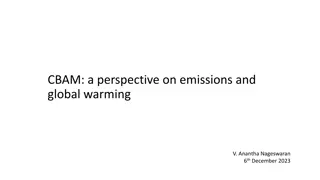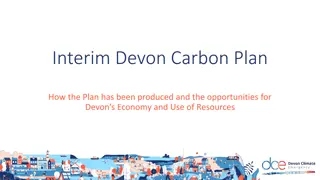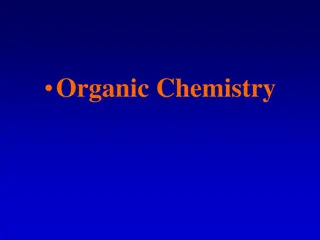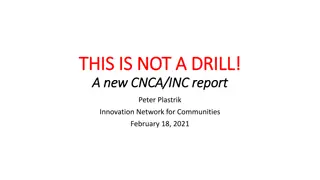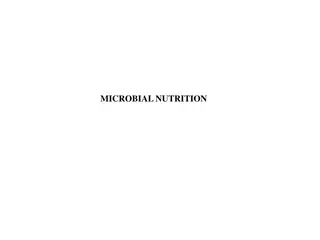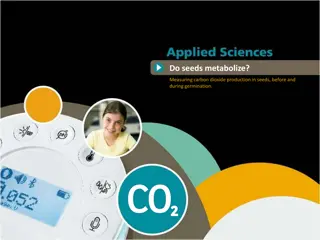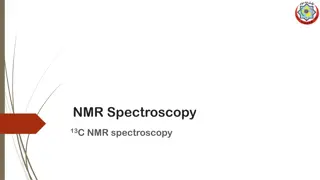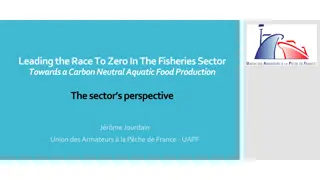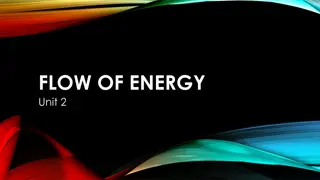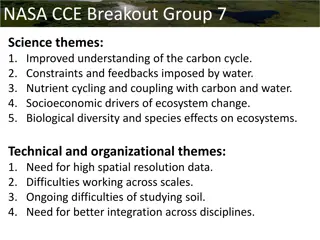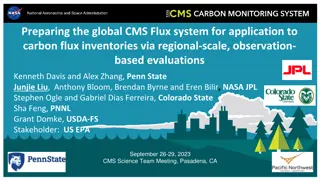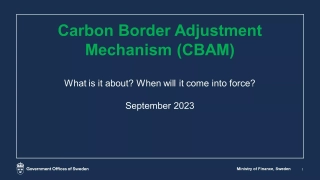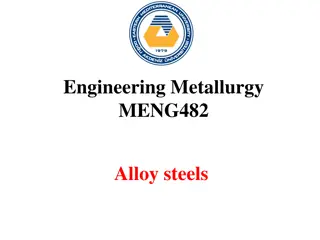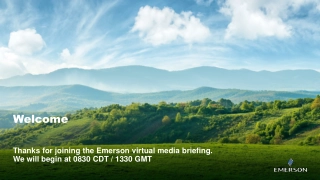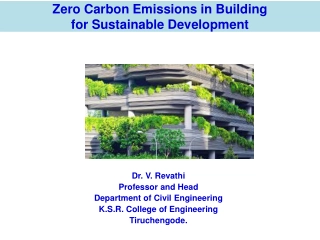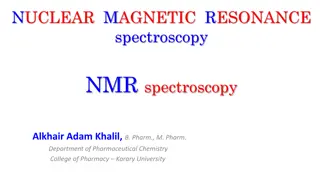Carbon Sequestration: A Comprehensive Overview
Explore a thorough overview of Carbon Capture and Storage (CCS) covering key projects, global CCS capacity, value chain processes, project development stages, and site selection criteria. Learn about the significant role of CCS in mitigating industrial and power emissions, contributing to sustainable development goals.
Download Presentation

Please find below an Image/Link to download the presentation.
The content on the website is provided AS IS for your information and personal use only. It may not be sold, licensed, or shared on other websites without obtaining consent from the author. Download presentation by click this link. If you encounter any issues during the download, it is possible that the publisher has removed the file from their server.
E N D
Presentation Transcript
Strictly Confidential Carbon Sequestration A Brief Overview Scott Rennie March 30th, 2022 info@vault4401.com
Vault 44.01 In Brief Team members have been major contributors to world-class CCS projects, including: Illinois Industrial CCS Project, ADM, Decatur, IL (1 MMTpa) (1) Shell Quest, AB, Canada (1 MMTpa) Aquistore / SaskPower Boundary Dam, SK, Canada (0.7 MMTpa) West Texas and Rockies enhanced oil recovery IEA GHG Weyburn-Midale Project, SK MMTpa = Million Metric Tonnes Per Annum (1) Source [Base Map]: North American sedimentary basins sourced from U.S. Department of Energy s NATCARB/ATLAS database 2
State of Sector - CCS In IEA s Sustainable Development Scenario, CCS grows by >100x in the next generation Industrial and Power emissions present an enormous target for CCS as an emissions mitigation tool CCS Capacity Existing Versus Required 2019 Global Energy-Related CO2 Emissions 8% 39% 26% 6.9 GtCO2/yr 27% Existing CCUS Capacity 0.04 GtCO2/yr Capacity Under Development 0.13 GtCO2/yr Power Plants Industrial Plants Transport Buildings Source: IEA, Sproule Analysis 3
CCS Value Chain Capture Transport Sequester Carbon Source CO2 3 Stage Integration 1 2 3 Capture plants take effluent streams from carbon producers (e.g., natural gas plant) and separate the offtake into CO2 and other substances The purified CO2 is compressed and either pipelined or trucked to the sequestration site The pure CO2 is injected into brine or hydrocarbon-bearing formations deep underground (over 13,000 CO2 injection wells in US alone) This site can sometimes be on the same location (e.g., reservoir underneath plant) Non-CO2 streams are vented or disposed of into landfills Alternate technologies are being developed that allow CO2 to be processed into cement or carbon black ( Utilization ) 4 4
Generalized CCS Project Development Process Plant site facilities & pipeline FEED Facilities & pipeline procurement Facilities & pipeline construction (1) CCS Project Operations Site selection & project scoping Storage site characterization & design Storage site construction Risk assessment & MRV program design Pore space rights acquisition Storage site permitting Stakeholder Engagement Project Finance | Insurance 5
Site Selection Criteria Finding and developing suitable sites for carbon sequestration involves ascertaining appropriate INJECTIVITY, CAPACITY and CONTAINMENT Property / Element Relevance to Feasibility Porosity Capacity of injection & relationship to permeability Permeability Seal quality to prevent upward migration; injectivity of storage zone (storage and confining zone) Depth Maintain supercritical state of CO2; separation from deepest source of drinking water Thickness Seal quality to prevent upward migration; Storage zone for capacity and injectivity (storage and confining zone) Pressure Pore pressure and fracture pressure (storage and confining zone) Salinity Regulations generally have minimum salinity requirements for carbon sequestration (10,000 ppm in USA) Regional features that may impact feasibility Wells penetrating storage complex, competing resource development, faulting and fracturing, seismicity Suitable geography Access, topography, stakeholder/landowner support, generally avoid population centers 6
Introduction to CO2 Sequestration Where does the CO2 go? Target Formations for Storage: Deep saline formations Depleted oil and gas reservoirs CO2 enhanced oil recovery (EOR) Deep unmineable coal seams Basalts Salt Caverns Storage complex: Subsurface geologic system comprising a storage formation, primary, and potentially secondary seals Image courtesy of Aquistore 7
Introduction to CO2 Sequestration What happens to the CO2? Trapping Mechanisms include: Physical trapping Storage formation should be bounded by impermeable layers Solubility trapping CO2 dissolves into the fluid phase Residual phase trapping CO2 trapped as a residual non-wetting phase Mineral trapping CO2 reacts with minerals in the formation to become part of the solid mineral matrix Image source: (Benson, 2005) 8
Technical Feasibility Study in a Picture Containment Capacity Injectivity Determine the deepest USDW (primary purpose of a Class VI permit is to ensure non-endangerment of USDWs) Identify all water wells in the area of review Evaluation of seal properties (thickness, porosity, permeability, depth) Relatively Impermeable Seal Relatively Permeable Storage Existing deep wells nearby that could be a conduit for CO2 to be avoided Evaluation of storage properties (thickness, porosity, permeability) Precambrian Basement Identify presence of basement highs to be avoided Identify presence of faults / fractures to be avoided Image source: NETL (2018) 9
Sequestration Well Development Injection Well Monitoring Well Injection wells provide access to inject into the target sequestration formation and appropriate monitoring provides information about project performance Deepest Source of Drinking Water Hydrocarbon Bearing Interval Monitoring wells can be designed to monitor in and/or above sequestration formation pressure, CO2 plume, seismicity Wells designed for long-term compatibility with CO2 especially pipe, cement, elastomers Secondary Sealing Formation Porous Monitoring Interval Primary Sealing Formation Injection Formation 10
Reservoir Monitoring Time Lapse 3D Seismic Sleipner Project (Norway) 3D seismic images Receivers: geophones with 3 in. spike into surface to capture source data Source: lowers vibration pad onto surface every 3-5 ft. 11
Rights to Access the Storage Formation Pore Space Illustrative CO2 plume simulation Reservoir modeling drives pore space acquisition requirements Impacted by project scale, and thickness and porosity of storage horizon Rights to access pore space need to be obtained USA: surface owner generally deemed to own pore space, unless rights have been severed Alberta / Canada: government/Crown generally owns pore space Ability to unitize or force pool land can be helpful Early and sincere stakeholder engagement is essential to project success Image Source: Global CCS - Pioneer Project (2012)
Rigorous Permitting Process (US EPA UIC Class VI) EPA Underground Injection Control (UIC) program primary mandate is to protect drinking water; governs injection processes in USA including carbon sequestration Required to demonstrate: Injection zone of sufficient areal extent, thickness, porosity, permeability and salinity to receive anticipated volumes Confining zone is free of faults and fractures, of sufficient areal extent and integrity to contain the injected carbon dioxide stream Identification of all underground sources of drinking water in which the concentration is less than 10,000 ppm TDS Maintenance of pore pressure in the injection zone at less than 90% of fracture gradient Rigorous application and approval process 9 sections in permit application substantial technical and planning work required 12 to 24 month approval timeline through EPA 13
Ensuring Efficacy: Financial Assurance and Insurance EPA requires demonstration of financial responsibility across four categories designed to ensure the long-term security of sequestered CO2 Certain jurisdictions allow transfer of ownership / liability to the government after a certain period of time or a sufficiently low level of leakage risk has been demonstrated Sequestration operator may need to provide a level of indemnification to entity capturing CO2 against financial loss due to leakage Some insurers preparing to provide policies covering certain financial risks, though market is immature Image Source: Class VI Guidance Documents 14
How Can CCS Be Profitable? Bankable monetization in place with potential to stack additional monetization pathways. 127 governments responsible for >60% of global emissions are making commitments to net zero.(1) CO2 Value Drivers Other Incentives: Discounted interest rates for credit facilities. Policy Value Term Who Qualifies? Monetization 45Q (Federal) $50/T - CCS (Storage) $35/T - EOR All industrial facilities and power generation facilities. 12 yrs. Tax equity Green Premiums: Emission-free or lower carbon intensity products priced at a premium. Low Carbon Fuel Standard LCFS (California) Tradable credit $140-200/T since mid-2018 CCS projects selling liquid fuel to CA market. DAC projects anywhere. No expiry Credit trading market Clean Fuel Standard CFS (Federal) 20 yrs. (+5 yrs.) Similar to CA LCFS except all industrial CCS projects qualify. TBD (C$300/T cap) Credit trading market Corporate Tax Incentives: Corporate taxes cut by 50% for companies making zero- emission technologies [Canada]. Carbon Tax (Federal) C$50/T (2022), increasing to C$170/T by 2030 No expiry All industrial emitters. GHG Offset System CCUS Investment Tax Credit (Federal) Details Pending Coming into effect in 2022; EOR projects unlikely to qualify. Additional Tailwinds: Clean Fuel Standard Expansion: Additional jurisdictions exploring regulations. Voluntary Credit Markets: >$300mm / year market size; CCS benefits from higher durability / permanence of verifiable carbon removal. New Tax Equity Markets: Emerging market of large, well capitalized investors incorporating carbon removal into their climate strategy (e.g., MSFT, AMZN, AAPL, SHOP). (1)Blackrock: Larry Fink s 2021 Letter to CEOs Strictly Confidential 15
Geology Works in Many Places but Far From All Suitable CO2 sequestration geology exists in many places UNsuitable CO2 sequestration geology exists in many places Development of infrastructure will help move transport CO2 when geology is unsuitable impact on project economics needs to be considered 16
Takeaways CO2 sequestration is a highly technical endeavor but the process and technologies are proven and done well, it provides a high degree of carbon mitigation security The three most important technical elements for a CO2 sequestration project are injectivity, capacity and containment Stakeholder engagement, pore space rights, permitting and financial security are equally important to project success CCS project success requires establishing trust between companies that often do not know very much about each others business Project economics / viability are highly variable depending on a multitude of factors The next set of CCS projects are being developed now Expect scaling as policy mechanisms strengthen, infrastructure develops and capture costs come down Image Source: Global CCS - Pioneer Project (2012) 17
Supplemental Materials 18 18
Phase Conditions for CO2 Optimal Depth for Storage / Injectivity: Storage must occur at depths below ~2,600 ft. to maintain a supercritical state (>1,070 psi) Dependent on reservoir pressure gradient Under pressured (0.38 psi/ft): ~2,800 ft Normally pressured (0.43 psi/ft): ~2,600 ft Gas phase carbon dioxide (CO2) is inefficient and less secure Decreased storage efficiency due to larger volumes (gas phase can only store 3% of the volume in the same space compared to supercritical state) Decreased storage security due to increased mobility of gas vs liquid It can be a challenge to maintain supercritical state while staying under fracture pressure at shallow depths (International Panel on Climate Change, 2005) 19


